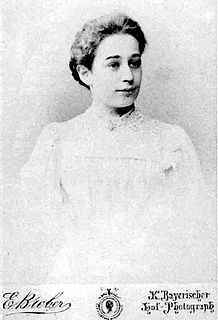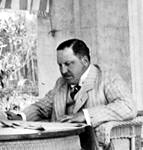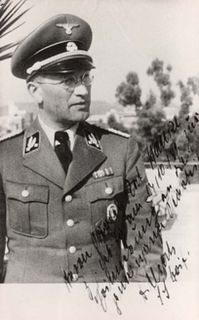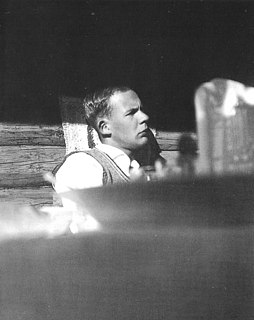
Reinhard Tristan Eugen Heydrich was a high-ranking German SS and police official during the Nazi era and a principal architect of the Holocaust. He was chief of the Reich Security Main Office. He was also Stellvertretender Reichsprotektor of Bohemia and Moravia. He served as president of the International Criminal Police Commission and chaired the January 1942 Wannsee Conference which formalised plans for the "Final Solution to the Jewish Question"—the deportation and genocide of all Jews in German-occupied Europe.

The Wannsee Conference was a meeting of senior government officials of Nazi Germany and Schutzstaffel (SS) leaders, held in the Berlin suburb of Wannsee on 20 January 1942. The purpose of the conference, called by the director of the Reich Security Main Office SS-Obergruppenführer Reinhard Heydrich, was to ensure the co-operation of administrative leaders of various government departments in the implementation of the Final Solution to the Jewish question, whereby most of the Jews of German-occupied Europe would be deported to occupied Poland and murdered. Conference participants included representatives from several government ministries, including state secretaries from the Foreign Office, the justice, interior, and state ministries, and representatives from the SS. In the course of the meeting, Heydrich outlined how European Jews would be rounded up and sent to extermination camps in the General Government, where they would be killed.

Fehmarn is an island in the Baltic Sea, off the eastern coast of Schleswig-Holstein, Germany, and c. 18 kilometers south of the Danish island of Lolland. It belongs to the district of Ostholstein, Germany.

Walter Friedrich Schellenberg was a German SS functionary during the Nazi era. He rose through the ranks of the SS, becoming one of the highest ranking men in the Sicherheitsdienst (SD) and eventually assumed the position as head of foreign intelligence for Nazi Germany following the abolition of the Abwehr in 1944.

Heinrich Müller was a high-ranking German Schutzstaffel (SS) and police official during the Nazi era. For the majority of World War II in Europe, he was the chief of the Gestapo, the secret state police of Nazi Germany. Müller was central in the planning and execution of The Holocaust and attended the January 1942 Wannsee Conference, which formalised plans for deportation and genocide of all Jews in German-occupied Europe—The "Final Solution to the Jewish Question". He was known as "Gestapo Müller" to distinguish him from another SS general named Heinrich Müller.

Wilhelm Stuckart was a German Nazi Party lawyer, official, and a State Secretary in the Reich Interior Ministry during the Nazi era. He was a co-author of the notorious Nuremberg Laws and was a participant in the Wannsee Conference that formulated the Final Solution. He also served as Reichsminister of the Interior in the short-lived Flensburg government at the end of the Second World War.

Gerhard Klopfer was a senior official of the Nazi Party and assistant to Martin Bormann in the Office of the (Nazi) Party Chancellery.

Else Ury was a German-Jewish novelist and children's book author. Her best-known character is the blonde doctor's daughter Annemarie Braun, whose life from childhood to old age is told in the ten volumes of the highly successful Nesthäkchen series. The books, the six-part TV series Nesthäkchen (1983), based on the first three volumes, as well as the new DVD edition (2005) caught the attention of millions of readers and viewers. During Ury's lifetime Nesthäkchen und der Weltkrieg, the fourth volume, was the most popular. Else Ury was a member of the German Bürgertum. She was pulled between patriotic German citizenship and Jewish cultural heritage. This situation is reflected in her writings, although the Nesthäkchen books make no references to Judaism. In 1943, Else Ury was deported to Auschwitz concentration camp, where she was murdered upon her arrival.

Joseph Wulf was a German-Polish Jewish historian. A survivor of the Auschwitz concentration camp, he was the author of several books about Nazi Germany and the Holocaust, including Das Dritte Reich und die Juden ; Heinrich Himmler (1960); and Martin Bormann: Hitlers Schatten (1962). The House of the Wannsee Conference museum in Berlin houses the Joseph Wulf Library in his honour.

Friedrich Minoux was a German industrialist and financier who is best known for being one of the owners of the Wannsee House, where the namesake conference that would decide the fate of millions at the hands of the Nazis during World War II was held in early 1942.

Richard Bruno Heydrich was a German opera singer (tenor), and composer. He was the father of SS-Obergruppenführer Reinhard Heydrich, an architect of the Final Solution, and Heinz and Maria Heydrich.

Lina Mathilde Manninen was the wife of Reinhard Heydrich, head of the Reich Security Main Office and a central figure in Nazi Germany. The daughter of a minor German aristocrat, she joined the Nazi Party in 1929 and met Reinhard Heydrich in December 1930. The two wed on 26 December 1931 and had four children. After World War II ended, she published a memoir in 1976. She spoke with several authors, wrote letters of correction to many newspapers, and defended the reputation of her first husband (Heydrich) until her death at age 74 in August 1985 in Fehmarn.

Heinz Siegfried Heydrich was the son of Richard Bruno Heydrich and the younger brother of SS-Obergruppenführer Reinhard Heydrich. After the death of his brother in June 1942, Heinz Heydrich helped Jews escape the Holocaust.

The Jacquier and Securius Bank was a prominent private bank founded in 1817 by August Jacquier and Henrich Securius. The bank's headquarters were located in central Berlin in a building nicknamed the Red Castle. Originally under Jewish ownership, the bank began the process of Aryanization in 1933, which Richard Lenz and Robert Kraus becoming the majority stakeholders.

Wannsee House and the Holocaust by Steven Lehrer tells the story of the elegant suburban Berlin villa where the Wannsee Conference took place on January 20, 1942. At that meeting, Reinhard Heydrich announced the plans for the deportation and extermination of all Jews in German-occupied territory. This to be coordinated with the representatives from the Nazi state agencies present at the meeting.

Ernst Ferdinand Emil Marlier was a German pharmaceutical manufacturer who built the Wannsee Villa, where the Wannsee Conference was held.

Karl Wilhelm Albert was a German SS officer.
Kriminalpolizei, often abbreviated as Kripo, is the German name for a criminal investigation department. This article deals with the agency during the Nazi era.

Erkki Mauno Gustaf Manninen was a Finnish poet, painter and theatre director. He was the son of poet Otto Manninen and writer Anni Swan. Manninen is best known as the founder of Intimiteatteri, which was one of the leading theatres in Helsinki from 1949 to 1987.
Georg Herbert Mehlhorn was an SS Oberführer, Nazi legal expert, and Gestapo official. Mehlhorn was involved in the camouflage of the mass graves of the Jewish victims in the forest of the Chełmno extermination camp. He operated gas wagons at the Chełmno camp to murder the sick Jewish prisoners who were sent from the Wartheland ghettoes. He was also a director of Stiftung Nordhav, a front organization of the Sicherheitsdienst founded in 1939 by Reinhard Heydrich, one of the main architects of the Holocaust. He was the mentor of SS-Brigadeführer Walter Schellenberg while at the SS-Hauptamt.


















